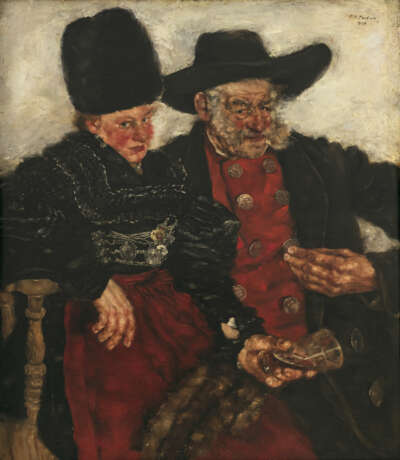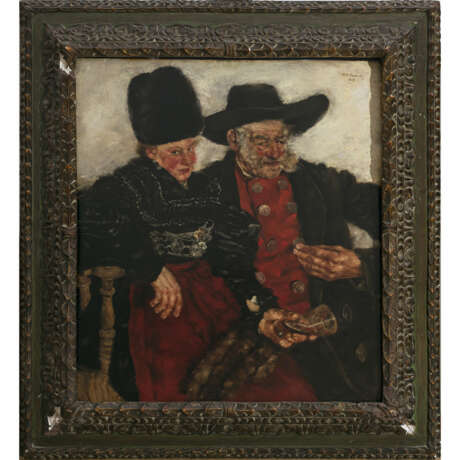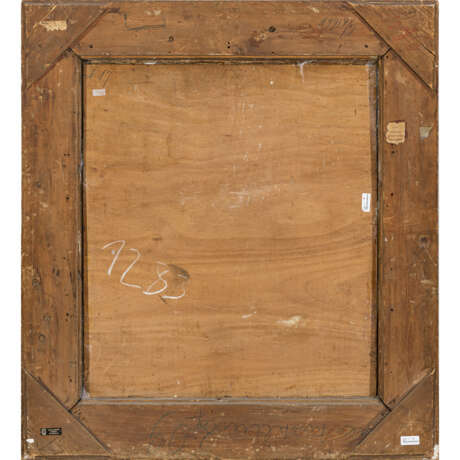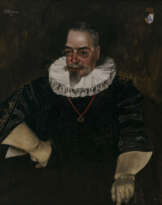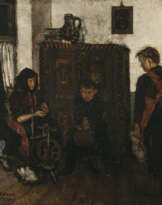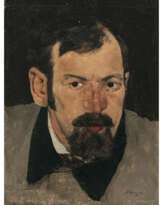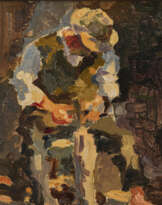ID 1190999
Lot 184 | Paul Mathias Padua. Peasant couple. 1926
Estimate value
€ 6 000 – 8 000
Bauernpaar. 1926
Paul Mathias Padua
Peasant couple. 1926
Signed and dated 1926 upper right. Label "Gerstenberger Ausstellung Chemnitz" and label "Galerie Schöninger, München" verso. Oil auf panel. 100 x 88 cm. Minor damage. Damage to frame (133 x 120.5 cm).
Der Mann trägt einen Backenbart, trägt einen Hut, einen dunklen Mantel mit großem silbernem Knöpfen sowie eine rote Weste mit großen Münzknöpfen. Die Frau zu seiner rechten trägt ein dunkles, verschnürtes Mieder sowie eine zur Weste des Mannes passende, rote Schürze. Auf ihrem Haupt trägt sie eine Ottermütze und in ihrer linken Hand hält sie ein fast leeres Glas, welches sie beinahe ausschüttet.
Schon Cranach hatte das Motiv des Ungleichen Paars in mehreren Werken dargestellt, und auch Padua verweist durch den Altersunterschied auf dieses Motiv. Und auch Wilhelm Leibl thematisiert das, wobei vor allem Leibl hier als Vorbild für Padua zu dienen scheint. So ist sein Werk identisch aufgebaut zu dem Gemälde "Das ungleiche Paar", welches sich heute im Städel-Museum in Frankfurt (Main) befindet (Inv.-Nr. 1340). Nach der Katalogisierung im Museumsführer spielt das Glas dort eine wichtige Rolle, da es auskippt, sollte der Alte Mann der jungen Dame zu Nahe kommen. Und auch die Farbe Rot findet sich bei Leibl in der Kleidung der Personen wieder. Und auch der Gesichtsausdruck der Dame sowie die Stuhllehne im Werk Leibls rezipiert Padua in seinem Gemälde.
Die Aussage dürfte identisch sein, wobei wir im Gemälde Paduas nicht sagen können, ob nicht schon ein Teil des Glases verschüttet wurde. In den Unterschieden zeigen sich jedoch die Eigenheiten Paduas: So ist die Kleidung des Bauern bei Padua wesentlich mehr im Fokus, dafür ist der Hintergrund auf eine weiße Wand ohne sonstige Versatzstücke reduziert. Was auch zu den Eigenarten Paduas gehört, sind die Hände: Wir sehen nur drei Hände, die allerdings alle vom Bauern sein können. Sie hat die gleichen großen, von der Sonne gebräunten Hände wie ihr Partner, die von harter Arbeit sprechen, antithetisch zur Kleidung. Das finden wir nicht bei der Dame im Gemälde Leibls. Padua fokussiert sich stärker als sein Vorbild auf die Menschen sowie die Tracht im Bild, nichts im Hintergrund lenkt die Betrachtenden davon ab. Das gilt auch für die Farbe: Die roten Stücke heben sich von restlichem Schwarz der Tracht förmlich ab, ebenso wie die rot angelaufenen Gesichter zu den schwarzen Kleidungsstücken und dem monochrom-weißen Hintergrund. Diese Feinheiten in der Farbgebung finden sich im Werk Leibls nur im Ansatz, Padua treibt diese jedoch auf die Spitze. Dennoch lässt sich anhand dieses Gemäldes sehr schön sehen, wie nah sich Padua an den Werken Leibls orientiert.
Literature on the comparison painting: Holzinger, Ernst (editor), Städelsches Kunstinstitut Farnkfur am Main. Die Gemälde des 19. Jahrhunderts. Textband. Frankfurt (Main) 1972, pages 179-180.
Provenance: Collection of Max Göring - Galerie Hugo Helbing, Munich, 4 December 1930, lot 86: Titled: "Ungleiches Paar". - Gerstenberger art exhibition, Chemnitz (label verso). - Galerie Schöninger, Munich (label verso). - Collection of Hans Constantin Faußner, Munich.
| Artist: | Paul Mathias Padua (1903 - 1980) |
|---|---|
| Auction house category: | Paintings 19th - 20th century |
| Artist: | Paul Mathias Padua (1903 - 1980) |
|---|---|
| Auction house category: | Paintings 19th - 20th century |
| Address of auction |
Kunstauktionshaus Neumeister Barer Str. 37 80799 München Germany | ||||||||||||||
|---|---|---|---|---|---|---|---|---|---|---|---|---|---|---|---|
| Preview |
| ||||||||||||||
| Phone | 089 231710-20 | ||||||||||||||
| Fax | 089 231710-50 | ||||||||||||||
| Buyer Premium | 30% | ||||||||||||||
| Conditions of purchase | Conditions of purchase | ||||||||||||||
| Business hours | Business hours
|
